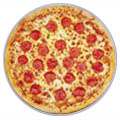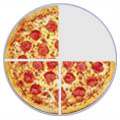Range
the positive difference between the largest and smallest values in a data set
Eg.
range of 4,8,5,6,9,1,3,5,8,6 is
1,3,4,5,5,6,6,8,8,9
9-1 = 8
Eg.
range of 4,8,5,6,9,1,3,5,8,6 is
1,3,4,5,5,6,6,8,8,9
9-1 = 8
 \
\






 |
Steps:
|
| Step 1: Find a number you can multiply the bottom of the fraction by to get 100. |
| Step 2: Multiply both top and bottom of the fraction by that number. |
| Step 3. Then write down just the top number with the "%" sign. |
| ×25 | ||
| 3 | = | 75 |
| 4 | 100 | |
| ×25 | ||
| ×6.25 | ||
| 3 | = | 18.75 |
| 16 | 100 | |
| ×6.25 | ||
| Step 1: Write down the decimal divided by 1, like this: decimal/1 |
| Step 2: Multiply both top and bottom by 10 for every number after the decimal point. (For example, if there are two numbers after the decimal point, then use 100, if there are three then use 1000, etc.) |
| Step 3: Simplify (or reduce) the fraction |
| 0.75 |
| 1 |
| × 100 | ||
| 0.75 | = | 75 |
| 1 | 100 | |
| × 100 | ||
| ÷5 | ÷ 5 | |||
| 75 | = | 15 | = | 3 |
| 100 | 20 | 4 | ||
| ÷5 | ÷ 5 | |||


| = |
| = |
|
  |
A Mixed Fraction
is a whole number and a proper fraction combined. such as 1 3/4. | |
| 1 3/4 | ||
| (one and three-quarters) |
| 2 3/8 | 7 1/4 | 1 14/15 | 21 4/5 |